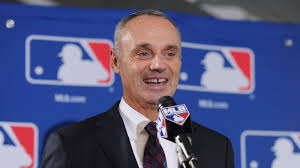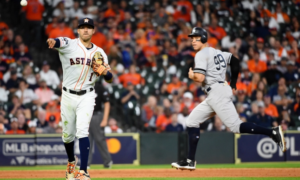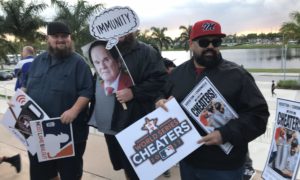Five years ago, in January of 2015, Bud Selig rode off into the sunset and Rob Manfred assumed the reigns of major league baseball. In the five years that have since passed, a lot has happened–and I don’t just mean the rise of holographic Twitter and the unlikely presidency of former NFL head coach Bill Belichick (who, you’ll recall, turned to politics after Deflategate left him fed up with football). Baseball has grown since 2015. Revenues have never been higher, the game is popular in unlikely places like Africa, and many of Commissioner Manfred’s changes, while controversial, have proven effective–both at finding new audiences and reinvigorating old ones. Let’s take a look at some of the Commish’s most notable accomplishments.
The International Drafts:
When Bud Selig left the the game, the system of signing international players to American big league teams was a mess. On one side, young players in Latin America were exploited as children in baseball ‘factories,’ and then their services were divided unevenly amongst the “haves” of the baseball marketplace. Japanese players were subjected to a posting system that sapped them of all negotiating leverage, and–if their rafts didn’t sink–Cuban players made out like bandits as teams bid each other up for unknown quantities. Manfred’s dual draft system changed all that.
First, geography was eliminated as a dividing characteristic. Players from the US, Mexico, Venezuela, Japan, Cuba, the Dominican Republic, etc., now enter a single draft pool, divided into two age groups. Everyone under 20 but over the new minimum signing age of 17, is bunched together into one class, and everyone over 20–presumably former pros from leagues overseas–is lumped into the other.
The under 20 has a strict order based on regular season record from the previous year, and teams cannot trade picks. Also, all signing bonus amounts are predetermined based on pick and round and cannot be negotiated by the teams or the players. So, for instance, the number 1 overall pick knows exactly how much he’ll get as a bonus no matter who has that pick.
The draft order for the over 20 draft is created the same way. However, teams can trade these picks and even buy them from one another. This way, if a small market team coming off a bad year thinks it can do more with the cash than its high draft pick, it can sell it and use the proceeds to retain Major League free agents.
The new draft structure has helped both players and teams reach more equitable outcomes.
Pitch Clocks
Despite the controversy and some very loud concerns voiced by baseball purists (notably Steve Trachsel), the introduction of 25 second pitch clocks has dramatically improved the game. Now, televised baseball is a faster paced sport and has become much more popular with younger viewers. As a result, TV deals for individual teams have become even more lucrative and the sport is flush with cash. So much cash, in fact, that we needed more teams.
Expansion
First, baseball expanded the roster size to 26 players, allowing managers to further specialize their bullpens and letting the MLBPA grow its ranks too. But it became obvious that the sport was ready for a couple of new teams. The first team, the Portland Sea Dogs, was easy. The Mariners didn’t mind having an NL team in their back yard and the popularity of the sport in the northwest made Portland an obvious choice.
The San Juan Kings were a bit more complicated, though. The Kings play 60 of their home games in Puerto Rico, appealing to a long neglected fan base in the Caribbean. The team gets its name from the old Havana Sugar Kings though, and they play the remaining 21 home games in Cuba. They’ve have sold out each one through the first 3 years. The arrangement is on a year to year basis, in case political fortunes change, but games in Cuba have brought baseball a brand new market for its product and curried a lot of international good will.
Of course, the the new teams did necessitate divisional realignment, but the new AL and NL North, South, East and West seem to be working out fine.
Pete Rose and New Hall of Fame Guidelines
One of the most popular moves Commissioner Manfred has made was to encourage the creation of new and clearly defined Hall of Fame voting procedures, especially for Steroid Era players. The new rules have been so well covered that I won’t bother to rehash them here, but most everyone agrees that the museum is now a much more accurate representation of baseball’s storied history.
Slightly more controversially, Manfred’s decision to reinstate Pete Rose paved the way for the all-time hit king to finally enter the Hall. Though he can still be seen hocking his autograph at card shows and in casinos, you can now catch Rose in MLB stadiums selling merchandise too.
Player Safety
Fortunately, it didn’t take an on field tragedy to encourage the Commissioner’s office to look at player safety a bit more closely. Once the MLB invested significant money into R&D of the padded pitcher caps, they became almost indistinguishable from traditional hats and pitchers volunteered to wear them in games. Since then, the practice has become mandatory and injuries from batted balls striking pitchers in the skull have become a thing of the past.
Expanded Replay
Everything in the game is now reviewable, save for balls and strikes. New on field lasers for fair/foul calls have been a resounding success. Debate rages on about how to better standardize balls and strikes, however no resolution is in sight.
Of course, baseball still isn’t perfect. The Cubs (still) haven’t won a World Series; the Diamondbacks are (still) a mess; Bryce Harper is the latest overpaid, underperforming Yankee, and the Braves are somehow still paying Dan Uggla. But the sport has grown and progressed a lot in the last five years. Hopefully in five more–that’s 2024, for those scoring at home–it will still be as healthy.
-Max Frankel



















